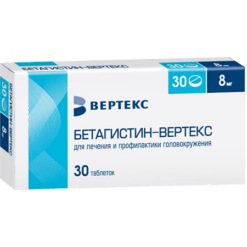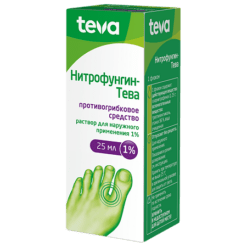-
×


-
×


Subtotal: €17.28




Subtotal: €17.28




Subtotal: €17.28
€1.00
Out of stock
(E-mail when Stock is available)
Pharmgroup:
antifungal agent.
Pharmic action:
Diflazon is an antifungal drug. Fluconazole, representative of the class of triazole antifungal agents, is a potent selective inhibitor of the fungal enzyme 14-α-demethylase. The drug prevents conversion of lanosterol into ergosterol – the main component of cell membranes of fungi.
It is active against pathogens of opportunistic mycoses, including those caused by Candida spp. (Candida albicans, Candida tropicalis), Cryptococcus neoformans, Microsporum spp, Trichophyton spp. Fluconazole activity has also been shown in models of endemic mycoses, including infections caused by Blastomyces dermatitidis, Coccidioides immitis and Histoplasma capsulatum.
Pharmacokinetics:
Intake
Fluconazole is well absorbed after oral administration. Bioavailability is 90%. After oral administration on an empty stomach in a dose of 150 mg, Cmax is 90% of the plasma level in a dose of 2.5-3.5 mg/l. Simultaneous intake of food has no effect on absorption when administered orally. Cmax is reached 0.5-1.5 hours after fluconazole administration. Plasma concentration is directly proportional to the dose taken.
Distribution
90% of Css is reached by 4-5 days of treatment with the drug (if administered once daily).
Administration of a shock dose (on day 1), 2 times the average daily dose, allows reaching 90% of Css by day 2. The apparent Vd is close to the total body water content. Protein binding is 11-12%.
Fluconazole penetrates well into all body fluids, including cerebrospinal fluid. Fluconazole concentrations in saliva and sputum are similar to its level in plasma. In patients with fungal meningitis, fluconazole levels in cerebrospinal fluid are about 80% of those in plasma.
In the stratum corneum, epidermis, dermis and sweat fluid, high concentrations are achieved that exceed serum levels.
Metabolism
Less than 5% of fluconazole is metabolized by “first passage” through the liver. No fluconazole metabolites have been detected in the blood.
Elimination
The long T1/2 allows a single dose of the drug for the treatment of vaginal candidiasis and provides once-daily administration for other indications. Fluconazole is mainly excreted by the kidneys; about 80% of the administered dose is excreted unchanged by the kidneys. Fluconazole clearance is proportional to creatinine clearance.
Cryptococcosis, including cryptococcal meningitis and other localizations of this infection (including lungs, skin), both in patients with a normal immune response and in patients with various forms of immunosuppression (including AIDS patients, organ transplants);
prevention of cryptococcal infection in patients with AIDS;
generalized candidiasis, including candidemia, disseminated candidiasis and other forms of invasive candidal infections (infections of the peritoneum, endocardium, eyes, respiratory and urinary tract). Treatment can be carried out in patients with malignant neoplasms, patients in intensive care units and undergoing cytostatic or immunosuppressive therapy, as well as in the presence of other factors predisposing to the development of candidiasis;
candidiasis of the mucous membranes, incl. oral cavity and pharynx (including atrophic candidiasis of the oral cavity associated with wearing dentures), esophagus, non-invasive bronchopulmonary candidiasis, candiduria, skin candidiasis;
prevention of relapse of oropharyngeal candidiasis in patients with AIDS;
genital candidiasis: vaginal candidiasis (acute and chronic recurrent), prophylactic use to reduce the frequency of relapses of vaginal candidiasis (3 or more episodes per year);
candidal balanitis;
prevention of fungal infections in patients with malignant neoplasms who are predisposed to such infections as a result of chemotherapy with cytostatics or radiation therapy;
mycoses of the skin, including mycoses of the feet, body, and groin area;
pityriasis versicolor;
onychomycosis;
skin candidiasis;
deep endemic mycoses, including coccidioidomycosis, paracoccidioidomycosis, sporotrichosis and histoplasmosis in patients with normal immunity.
Pharmaceutical group:
antifungal agent.
Pharmaceutical action:
Diflazon is an antifungal drug. Fluconazole, a member of the triazole antifungal class, is a potent selective inhibitor of the fungal enzyme 14-α-demethylase. The drug prevents the transition of lanosterol to ergosterol, the main component of fungal cell membranes.
Active against pathogens of opportunistic mycoses, incl. caused by Candida spp. (Candida albicans, Candida tropicalis), Cryptococcus neoformans, Microsporum spp., Trichophyton spp. Fluconazole has also been shown to be active in models of endemic mycoses, including infections caused by Blastomyces dermatitidis, Coccidioides immitis and Histoplasma capsulatum.
Pharmacokinetics:
Suction
After oral administration, fluconazole is well absorbed. Bioavailability is 90%. After taking the drug orally on an empty stomach at a dose of 150 mg, Cmax is 90% of the plasma content with intravenous administration of the drug at a dose of 2.5-3.5 mg/l. Concomitant food intake does not affect oral absorption. Cmax is achieved 0.5-1.5 hours after taking fluconazole. Plasma concentration is directly proportional to the dose taken.
Distribution
90% Css is achieved by day 4-5 of treatment with the drug (when taken once a day).
Administration of a loading dose (on day 1), 2 times higher than the average daily dose, allows you to achieve a 90% Css level by day 2. The apparent Vd approaches the total water content of the body. Protein binding – 11-12%.
Fluconazole penetrates well into all body fluids, including cerebrospinal fluid. Concentrations of fluconazole in saliva and sputum are similar to its plasma levels. In patients with fungal meningitis, fluconazole levels in the cerebrospinal fluid are approximately 80% of plasma levels.
In the stratum corneum, epidermis, dermis and sweat fluid, high concentrations are reached that exceed serum concentrations.
Metabolism
Less than 5% of fluconazole is metabolized during the first pass through the liver. No fluconazole metabolites were detected in the blood.
Removal
Long T1/2 allows the use of a single dose of the drug for the treatment of vaginal candidiasis and ensures that the drug is taken 1 time per day. for other indications. Fluconazole is excreted primarily by the kidneys; approximately 80% of the administered dose is excreted unchanged by the kidneys. Fluconazole clearance is proportional to creatinine clearance.
Treatment can be started in the absence of culture or other laboratory test results, but if they are available, appropriate adjustment of fungicidal therapy is recommended.
Fluconazole
1 capsule contains:
Active substance:
fluconazole 150 mg;
Excipients:
lactose monohydrate;
corn starch;
anhydrous colloidal silicon dioxide;
sodium lauryl sulfate;
magnesium stearate.
The use of Diflazon during pregnancy is not advisable, with the exception of severe or life-threatening forms of fungal infections, if the expected benefit to the mother outweighs the possible risk to the fetus.
Fluconazole is found in breast milk in the same concentration as in plasma, so the use of the drug during lactation is not recommended.
Hypersensitivity to fluconazole, other components of Diflazon or other azole compounds;
simultaneous use of terfenadine (while constantly taking fluconazole at a dose of 400 mg/day or more), cisapride or astemizole and other drugs that prolong the QT interval and increase the risk of developing severe arrhythmias;
lactation period.
From the digestive system: nausea, diarrhea, flatulence, vomiting, abdominal pain, change in taste, rarely – increased activity of liver enzymes and impaired liver function (jaundice, hyperbilirubinemia, increased activity of ALT, AST and alkaline phosphatase, hepatitis, hepatocellular necrosis, including death).
From the nervous system: headache, dizziness; rarely – convulsions.
From the hematopoietic organs: rarely – agranulocytosis, neutropenia. Patients with severe fungal infections may experience hematological changes (leukopenia and thrombocytopenia).
From the cardiovascular system: increased duration of the QT interval on the electrocardiogram (ECG), ventricular fibrillation/flutter.
Allergic reactions: skin rash, exudative erythema multiforme (including Stevens-Johnson syndrome), toxic epidermal necrolysis (Lyell’s syndrome), bronchial asthma (more often with intolerance to acetylsalicylic acid), anaphylactoid reactions (including angioedema, facial edema, urticaria, itching).
When fluconazole was used with warfarin, an increase in prothrombin time by 12% was observed. In this regard, it is recommended to monitor prothrombin time in patients receiving Diflazon in combination with coumarin anticoagulants.
With simultaneous use, fluconazole increases T1/2 of oral hypoglycemic drugs – sulfonylurea derivatives (chlorpropamide, glibenclamide, glipizide and tolbutamide) in healthy volunteers. Co-administration of fluconazole and oral hypoglycemic drugs is allowed, but the possibility of developing hypoglycemia should be taken into account.
Concomitant use of fluconazole and phenytoin may be accompanied by an increase in phenytoin concentrations to a clinically significant extent. If concomitant use of two drugs is required, phenytoin levels should be monitored and the dose adjusted to ensure therapeutic serum concentrations.
The simultaneous use of fluconazole and rifampicin leads to a decrease in AUC by 25% and a shortening of half-life of fluconazole by 20%. In patients receiving concomitant rifampicin, it is necessary to consider the advisability of increasing the dose of fluconazole.
It is recommended to monitor the concentration of cyclosporine in the blood in patients receiving fluconazole, because When using fluconazole and cyclosporine in patients with a kidney transplant, taking fluconazole at a dose of 200 mg/day slowly increased the concentration of cyclosporine.
Patients receiving high doses of theophylline, or who are at risk of developing theophylline toxicity, should be monitored for early detection of symptoms of theophylline overdose, as simultaneous administration of fluconazole leads to a decrease in the average rate of clearance of theophylline from plasma.
With the simultaneous use of fluconazole and cisapride, cases of adverse reactions from the heart, including paroxysms of ventricular tachycardia (pirouette-type arrhythmia), have been described.
There are reports of interaction between fluconazole and rifabutin, accompanied by an increase in serum levels of the latter. With the simultaneous use of fluconazole and rifabutin, cases of uveitis have been described. Patients receiving rifabutin and fluconazole simultaneously should be carefully monitored.
With the simultaneous use of zidovudine and fluconazole, an increase in the concentration of zidovudine in plasma is observed, which is caused by a decrease in the conversion of the latter into the main metabolite, so an increase in the side effects of zidovudine should be expected.
Symptoms: hallucinations, paranoid behavior.
Treatment: gastric lavage and symptomatic therapy are recommended. Since fluconazole is excreted in the urine, forced diuresis increases its excretion. Hemodialysis for 3 hours reduces the concentration of fluconazole in plasma by 50%.
At a temperature not exceeding 25 °C
5 years
KRKA dd Novo Mesto, Slovenia
| Shelf life | 5 years |
|---|---|
| Conditions of storage | At a temperature not exceeding 25 °C |
| Manufacturer | KRKA dd Novo mesto, Slovenia |
| Medication form | capsules |
| Brand | KRKA dd Novo mesto |
Buy Diflazon, 150 mg capsules with delivery to USA, UK, Europe and over 120 other countries.